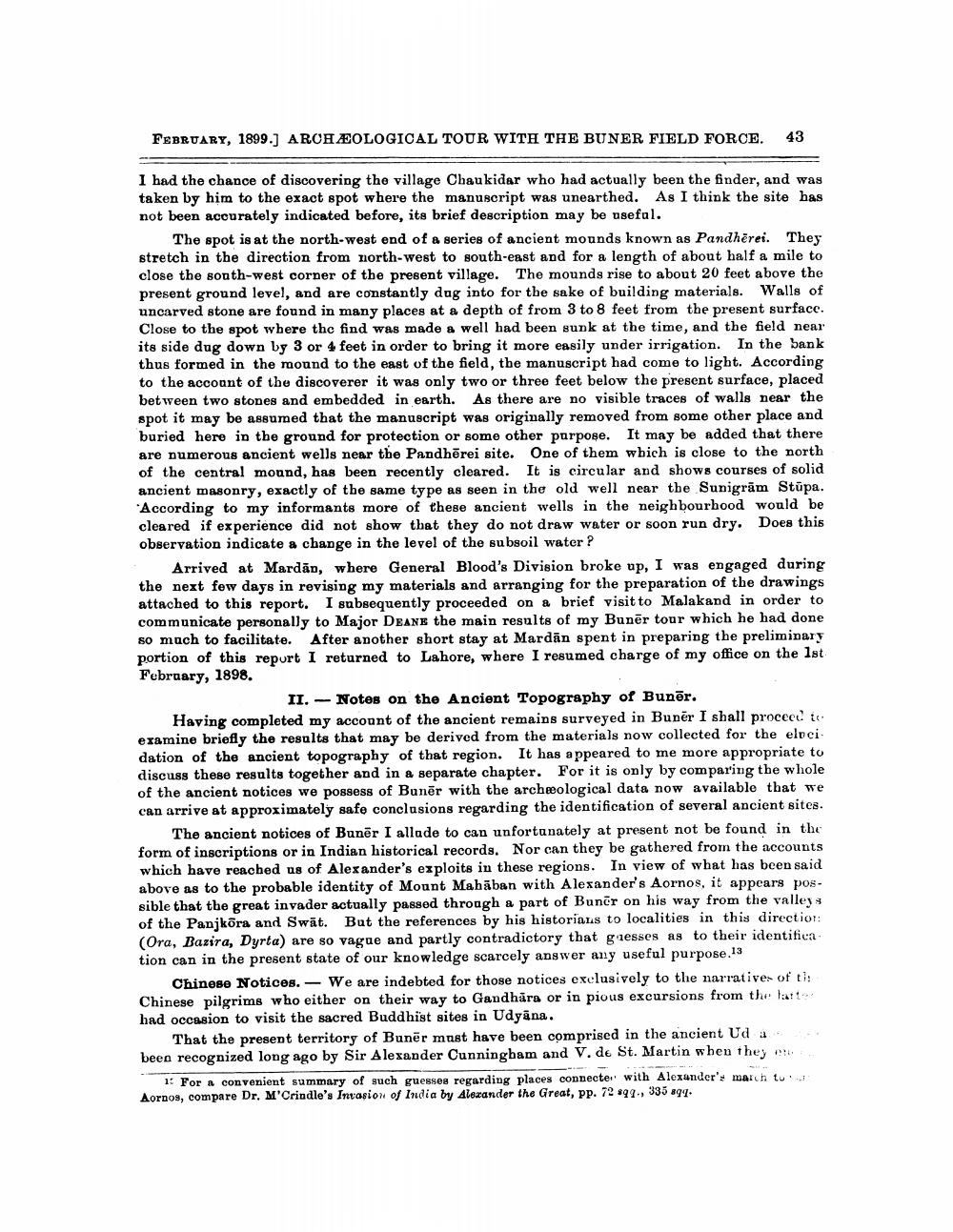________________
FEBRUARY, 1899.) ARCHÆOLOGICAL TOUR WITH THE BUNER FIELD FORCE. 43
I had the chance of discovering the village Chaukidar who had actually been the finder, and was taken by him to the exact spot where the manuscript was unearthed. As I think the site has not been accurately indicated before, its brief description may be useful.
The spot is at the north-west end of a series of ancient mounds known as Pandhērei. They stretch in the direction from north-west to south-east and for a length of about half a mile to close the south-west corner of the present village. The mounds rise to about 20 feet above the present ground level, and are constantly dag into for the sake of building materials. Walls of uncarved stone are found in many places at a depth of from 3 to 8 feet from the present surface. Close to the spot where the find was made a well had been sunk at the time, and the field near its side dug down by 3 or 4 feet in order to bring it more easily under irrigation. In the bank thus formed in the mound to the east of the field, the manuscript had come to light. According to the account of the discoverer it was only two or three feet below the present surface, placed between two stones and embedded in earth. As there are no visible traces of walls near the spot it may be assumed that the manuscript was originally removed from some other place and buried here in the ground for protection or some other purpose. It may be added that there are numerous ancient wells near the Pandhērei site. One of them which is close to the north of the central mound, has been recently cleared. It is circular and shows courses of solid ancient masonry, exactly of the same type as seen in the old well near the Sunigrām Stūpa. According to my informants more of these ancient wells in the neighbourhood would be cleared if experience did not show that they do not draw water or soon run dry. Does this observation indicate a change in the level of the subsoil water?
Arrived at Mardan, where General Blood's Division broke up, I was engaged during the next few days in revising my materials and arranging for the preparation of the drawings attached to this report. I subsequently proceeded on a brief visit to Malakand in order to communicate personally to Major DEANE the main results of my Bunēr tour which he had done so much to facilitate. After another short stay at Mardān spent in preparing the preliminary portion of this report I returned to Lahore, where I resumed charge of my office on the 1st February, 1898.
II. - Notes on the Ancient Topography of Bunőr. Having completed my account of the ancient remains surveyed in Bunēr I shall proceed to examine briefly the results that may be derived from the materials now collected for the eloci dation of the ancient topography of that region. It has appeared to me more appropriate to discuss these results together and in a separate chapter. For it is only by comparing the whole of the ancient notices we possess of Bunēr with the archeological data now available that we can arrive at approximately safe conclusions regarding the identification of several ancient sites.
The ancient notices of Bunēr I allude to can unfortunately at present not be found in the form of inscriptions or in Indian historical records. Nor can they be gathered from the accounts which have reached us of Alexander's exploits in these regions. In view of what has been said above as to the probable identity of Mount Mahāban with Alexander's Aornos, it appears possible that the great invader actually passed through a part of Bunor on his way from the valleys of the Panjköra and Swāt. But the references by his historians to localities in this direction: (Ora, Bazira, Dyrta) are so vague and partly contradictory that giesses as to their identifica tion can in the present state of our knowledge scarcely answer any useful purpose. 13
Chinese Notices. We are indebted for those notices exclusively to the narratives of th: Chinese pilgrims who either on their way to Gandhåra or in pious excursions from the latte had occasion to visit the sacred Buddhist sites in Udyana.
That the present territory of Bunör must have been comprised in the ancient Uda been recognized long ago by Sir Alexander Cunningham and V. de St. Martin when they
1: For a convenient summary of such guesses regarding places connecter with Alexander's march tu Aornos, compare Dr. M'Crindle's Invasion of India by Alexander the Great, PP. 72 99., 335 894.




